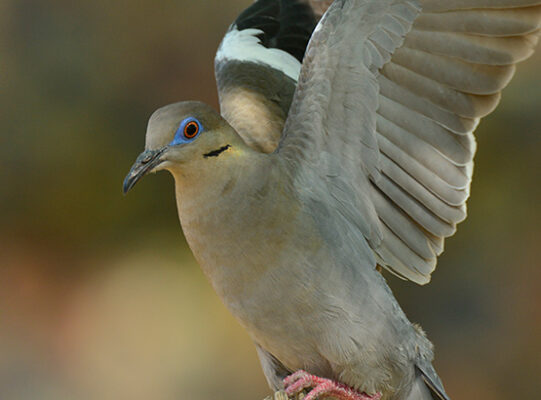Read the Small Game Forecast, by Species
Taking advantage of the myriad of opportunities to hunt small game will get you out to see some of Arizona’s most beautiful and remote landscapes!

Small game forecast by species and tips from R. Babb for hunting
2023 Small Game Forecast
By Dr. Larisa Harding
Arizona Game and Fish Department, Small Game Program
With Montezuma quail (Mearns’) and waterfowl data still rolling in through the summer and fall, the outlook for other small game species looks promising. Higher levels of precipitation received this past winter have encouraged most small game species to flourish through the spring, with expectations that they’ll persist if summer temperatures remain moderately warm with usual levels of monsoon rainfall. Here’s how the small game outlook shapes up as of late June, and watch for Arizona Game and Fish Department social media posts and email updates (subscribe at azgfd.gov) for additional harvest conditions.
Hunters provide critical field data for managing small game species, so the department would like to remind all small game hunters to complete and return the Small Game/ Predator-Furbearer survey that was mailed out this spring.
dove
The white-winged dove call count gives the department an index of the bird’s breeding activity and expresses what can be expected for breeding and trends for fall harvest. Mourning doves across the country are showing somewhat of a decline, however, this fall it’s anticipated that significantly more white-winged doves will be available for harvest. This is good news for fall and winter dove hunters if a big storm doesn’t kick doves into migratory mode right before the season opens. Visit yumadovehunting.com to explore dove hunting opportunities and activities in Yuma.
small game hunt challenge
If you like to set goals and want to experience the satisfaction of completing a worthy challenge, consider participating in the Arizona Small Game Challenge, which comprises four series recognizing the diverse landscapes and hunting opportunities throughout the state.
Hosted by the Valley of the Sun Quail Forever Chapter (VOTSQF), and sponsored by AZGFD, the challenges aim to expose hunters to learning about new species, harvesting different game and seeing new parts of the state. Seeking out, cooking and tasting new game are fringe benefits. Each person who completes one of the four challenges receives an engraving tab for that challenge and a plaque that includes space to place each of the remaining challenge tabs. Additionally, VOTSQF matches registration fees dollar-for-dollar to enhance Arizona habitats for quail and other small game.
The department’s own Nathan Fyffe, a small game biologist, recently became the first person to complete all four small game challenges. In 2019, a year after the challenges became available, Fyffe began his small game journey and pursued all three dove species, cottontail rabbit and Gambel’s quail. In 2020, he registered for the Mountain Challenge, harvesting red squirrel, Kaibab Abert’s squirrel, grouse, band-tailed pigeon and Abert’s squirrel. In 2021, he completed the Native Quail Challenge, and last year, he tackled the Ultimate Upland Bird Challenge successfully with friend and fellow hunter Michael Cravens of the Arizona Wildlife Federation. The two harvested their final birds of the challenge within minutes of each other.
dusky grouse
AZGFD would like to increase dusky grouse hunter survey participation. Grouse hunters, please send your mailing address or email address to smallgame@azgfd.gov to help the department gather information about dusky grouse populations. If you’re hunting early season archery elk in areas where dusky grouse persist, you may receive a questionnaire asking to report grouse observations.
Quail
At publication time, Gambel’s quail data is reporting an increase in call numbers, overall. Due to a good amount of winter rain and spring call surveys, small game managers believe desert quail numbers should be much higher this fall compared to 2022.
It is a plus that many baby quail were seen on the ground in the spring, with precipitation assisting the flush of green-up that quail are so dependent on. Winter rains induced breeding activity that may translate to higher Gambel’s numbers come harvest season. The visibility of young quail in recent months could mean predator impacts will be reduced and higher quail numbers will persist through the summer.
Mearns’ had a healthy reproductive season last year, supported by good monsoonal moisture. If those now-adult populations carried over to this year and monsoon precipitation is consistent this summer, Mearns’ numbers may improve this winter with a fresh crop of young birds.
rabbit
Due to recent years of serious drought and rabbit hemorrhagic disease, or RHDV2 (a fatal disease that spread rapidly among native rabbits in 2020), rabbit populations have generally been low across the state. The generous levels of rain received earlier this year may encourage reproduction and help young jackrabbits and cottontails survive, although in conservative numbers. It is thought that RHDV2 may reach endemic levels this year, affecting smaller numbers of rabbits than previous years.
Antelope jackrabbits may have been affected more seriously by the virus and will need more time to recover. If you do hunt rabbits, be sure to adhere to the new bag and possession limits set for cottontails and jackrabbits.
squirrel
High-country squirrel persistence is uncertain due to the generous amounts of snow that fell up north last winter. As deep and persistent snow fell in squirrel habitats, tree squirrels were certainly challenged to find food. It is likely harvest will occur in low numbers for high-country tree squirrels. The weather this summer will help to better estimate the persistence and potential reproduction of squirrels later this year.
Small game hunting tips
By Randall D. Babb
Read the tips
Want to Go Hunting in Arizona?
Find ways to experience big game and small game hunting or find a mentored hunt camp.
buy your hunting license
Arizona residents and non-residents 10 years and older need a valid hunting license to hunt in Arizona.
find a mentored hunt camp
The award-winning Outdoor Skills Network is your source for hands-on, learn-to-hunt events.
